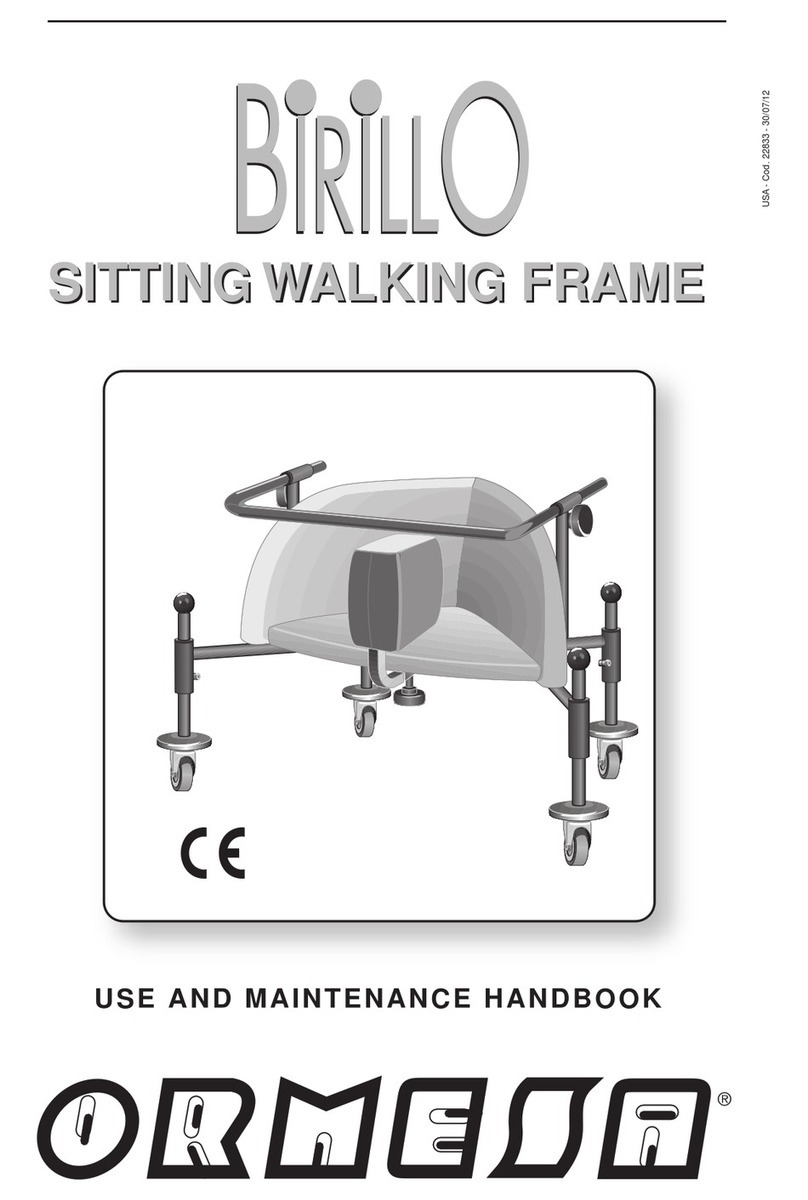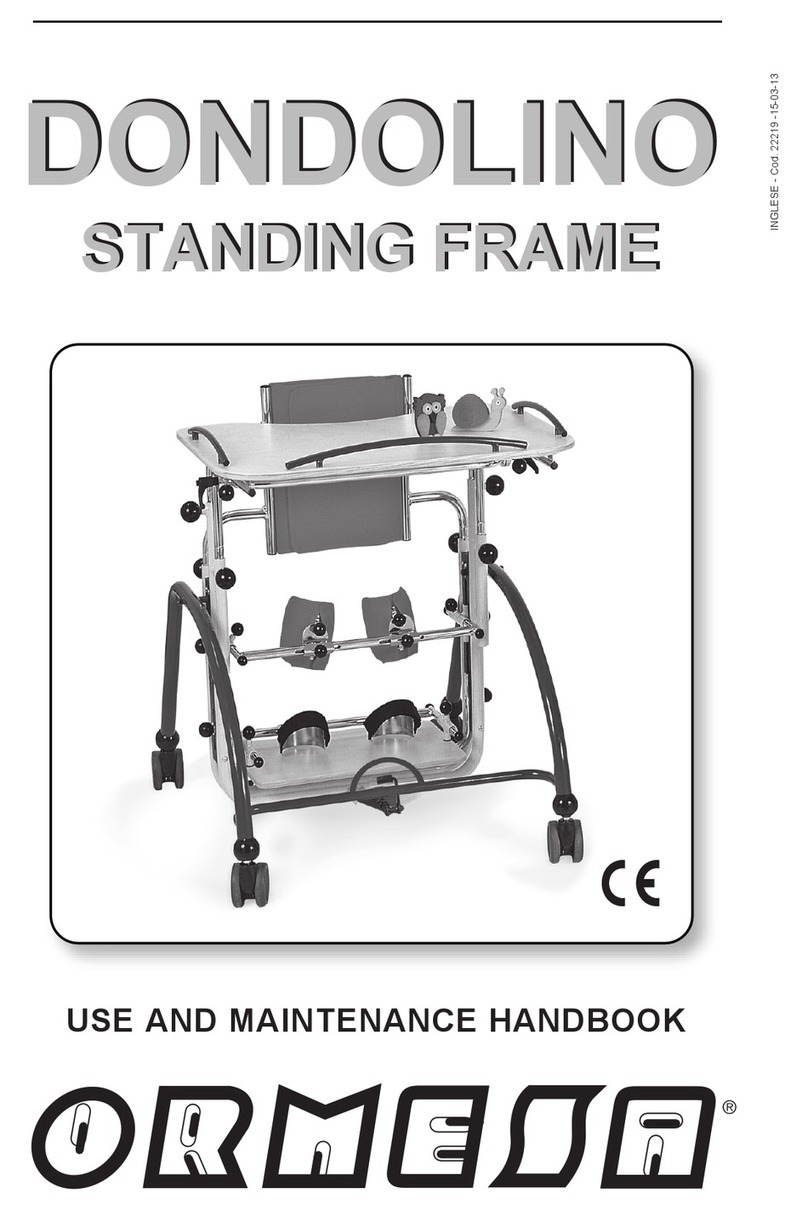Ormesa STANDY 3 Manual

USA - Cod. 22244 - 30-01-2018
STANDY 4
STANDY 3
STANDY 4
STANDY 3
USE AND MAINTENANCE HANDBOOK
STANDING FRAME FOR
THE UPRIGHT POSITION
STANDING FRAME FOR
THE UPRIGHT POSITION

Thank you for choosing STANDY, from ORMESA s.r.l.
The STANDY combines style and ergonomics without compromising on safety.
ORMESA recommends that you read this manual very carefully to fully
understand its contents. In addition to helping you become familiar with STANDY
quickly, it also contains practical tips for making the best use of it safely and keeping it
in good working order.
Following the recommendations of this manual will help you achieve the rehabilitative
goal for which this aid was developed.
Luigi Menichini
Managing Director
1/45

2/45
TABLE OF CONTENTS
WARNINGS...................................................................................................................4
LABELS AND PLATES ................................................................................................7
CONFORMITY DECLARATION ...................................................................................7
SOME EXAMPLES OF WHAT NOT TO DO WITH STANDY........................................ 8
HOW TO MOVE STANDY..........................................................................................9
INITIAL PREPARATION.............................................................................................10
PACKING INFORMATION........................................................................................10
TECHNICAL CHARACTERISTICS STANDY 3..........................................................11
TECHNICAL CHARACTERISTICS STANDY 4..........................................................12
HOW TO USE STANDY..............................................................................................13
WHAT DOES STANDY DO.........................................................................................13
HOW STANDY WORKS.............................................................................................14
HOW TO ASSEMBLE STANDY .................................................................................16
Fitting the WORK TABLE on STANDY 3................................................................... 16
Fitting the WORK TRAY on STANDY 4....................................................................17
HOW TO ADJUST STANDY.......................................................................................18
Adjusting the height of the CHEST SUPPORT on STANDY 3................................... 19
Adjusting the height of the CHEST SUPPORT on STANDY 4.................................. 20
Adjusting the height of the HAND SUPPORT RING and BACK SUPPORT on STANDY 3...... 21
Adjusting the depth of the BACK SUPPORT on STANDY 3.................................... 23
Adjusting the height of the HAND SUPPORT RING and BACK SUPPORT on STANDY 4... 22
Adjusting the depth of the BACK SUPPORT on STANDY 4.................................... 24
Adjusting the width, height and depth of the KNEEPADS on STANDY 3 and STANDY4...25
Adjusting the HEEL STOPS on STANDY 3 and STANDY 4.................................... 28
Adjusting the height of the WORK TABLE on STANDY 3........................................ 29
Adjusting the height of the WORK TRAY on STANDY 4 ......................................... 29
Adjusting the depth of the WORK TABLE on STANDY 3 ........................................ 30
Adjusting the depth of the WORK TRAY on STANDY 4 during use ........................ 30
Opening the BACK SUPPORT on STANDY 3......................................................... 31
Opening the BACK SUPPORT on STANDY 4......................................................... 32

3/45
How to remove the HANDLE on STANDY 4.............................................................. 33
MOUNTING AND ADJUSTMENT OF ACCESSORIES............................................... 34
SIDE SUPPORT 857 on STANDY 3.......................................................................... 34
SIDE SUPPORT 857 on STANDY 4.......................................................................... 35
4–WHEEL SET 861 on STANDY 3............................................................................ 36
4-WHEEL SET 861 on STANDY 4 ............................................................................ 37
HEADREST 865 on STANDY 3................................................................................. 38
HEADREST 865 on STANDY 4................................................................................. 39
FRONT FOOT RESTRAINTS with BELTS 902 on STANDY 3.................................. 41
FRONT FOOT RESTRAINTS with BELTS 902 on STANDY 4.................................. 42
MAINTENANCE, CLEANING AND DISINFECTION.................................................... 43
CUSTOMER SERVICE AND SPARE PARTS ............................................................. 44
CONDITIONS FOR DURABILITY, REUSE AND REASSIGNMENT TOA NEW USER
..................................................................................................................................... 45

WARNINGS
-CAREFULLY READ AND UNDERSTAND THE INSTRUCTIONS IN THIS MANUAL
BEFORE USING THE DEVICE BECAUSE THEY HAVE BEEN WRITTEN WITH THE
USER'S SAFETY IN MIND and they will help the carer use the product safely and keep
it in good working order. The Use and Maintenance Manual is an integral part of the
product and must be carefully preserved for future reference.
-THE MANUAL IS INTENDED FOR TECHNICALLY QUALIFIED RETAILERS AND
FOR USERS AND THEIR ASSISTANTS; it provides instructions for using the product
correctly and must be supplemented by adequate knowledge of the rehabilitation pro-
gram for which it has been prescribed.
-The manual reflects the technical state of the product at the time it was sold.
ORMESA RESERVES THE RIGHT TO MAKE ANY CHANGES TO THE PRODUCT
OR MANUAL suggested by experience, technical considerations or regulatory devel-
opments without any obligation to update its previous production and relevant manuals.
-STANDY must be prescribed by a MEDICAL SPECIALIST who will also supervise
its use.
-ATTENZIONE!: REGOLATE lo stabilizzatore secondo LA CORRETTA POSIZIONE
per l’utilizzatore (v. § «COME REGOLARE STANDY» da pag. 18).
-ATTENZIONE!: After adjusting STANDY, make sure that all adjustable parts have
been locked, so to prevent dangerous situations (follow the instructions in sec-
tion HOW TO ADJUST STANDY from pag. 18).
-STANDY must only be used by persons whose bodily measurements and weight
conform to the specifications in the paragraph “TECHNICAL CHARACTERISTICS” on
pages 11 and 12.
-STANDY is designed for only internal use.
-ATTENTION! The product is not fireproof, so keep STANDY far from flames, ciga-
rettes or fires.
4/45
Other manuals for STANDY 3
1
This manual suits for next models
1
Table of contents
Other Ormesa Medical Equipment manuals
Popular Medical Equipment manuals by other brands

Getinge
Getinge Arjohuntleigh Nimbus 3 Professional Instructions for use

Mettler Electronics
Mettler Electronics Sonicator 730 Maintenance manual

Pressalit Care
Pressalit Care R1100 Mounting instruction

Denas MS
Denas MS DENAS-T operating manual

bort medical
bort medical ActiveColor quick guide

AccuVein
AccuVein AV400 user manual














